Taisir El-Gorashi
Predictive and Proactive Power Allocation For Energy Efficiency in Dynamic OWC Networks
May 03, 2025



Abstract:Driven by the exponential growth in data traffic and the limitations of Radio Frequency (RF) networks, Optical Wireless Communication (OWC) has emerged as a promising solution for high data rate communication. However, the inherently dynamic nature of OWC environments resulting from user mobility, and time-varying user demands poses significant challenges for enhanced and sustainable performance. Energy efficiency (EE) is a critical metric for the sustainable operation of next generation wireless networks. Achieving high EE in dynamic OWC environments, especially under time-varying user distributions and heterogeneous service requirements, remains a complex task. In this work, we formulate a discrete-time EE optimisation problem in a dynamic OWC to maximise energy efficiency through determining user connectivity and power allocation. Solving this problem in real time is computationally demanding due to the coupling of user association and power allocation variables over discrete time slots. Therefore, we propose a Probabilistic Demand Prediction and Optimised Power Allocation (PDP-OPA) framework which predicts user arrivals, departures, and traffic demands. Based on these predictions, the framework proactively determines AP-user associations and allocates power dynamically using a Lagrangian-based optimisation strategy. Simulation results demonstrate that the proposed PDP-OPA significantly enhances system performance, providing solutions close to the optimal ones. The proposed framework improves energy efficiency, sum rate, and bit error rate (BER) compared to distance-based user association and uniform power allocation, validating its effectiveness for real time and adaptive resource management in dynamic OWC systems.
ANN-Driven Adaptive Power Allocation for OWC
Apr 06, 2025Abstract:Vertical-cavity surface-emitting lasers (VCSELs) have gained popularity in Optical Wireless Communication (OWC) due to their high bandwidth and directional beam compared to Light-emitting diodes (LEDs). In this work, we explore the deployment of VCSELs as Access Points (APs) in an indoor environment with time-varying user distributions and traffic demands. To enhance performance, a merged access point (MAP) topology is introduced to extend the serving area of each cell using Zero Forcing (ZF) for interference management. A power allocation optimisation problem is formulated aimed at maximising the sum rate of the dynamic network. Deterministic approaches can solve the formulated problem but are impractical for real-time scenarios. In this work, we propose an Artificial Neural Network (ANN) for adaptive power allocation with reduced computational complexity. Our results show that the designed ANN learns and effectively provides instantaneous solutions in dynamic scenarios, resulting in improved performance in terms of sum rate compared to a baseline uniform power allocation scheme.
AI-Driven Resource Allocation in Optical Wireless Communication Systems
Apr 08, 2023Abstract:Visible light communication (VLC) is a promising solution to satisfy the extreme demands of emerging applications. VLC offers bandwidth that is orders of magnitude higher than what is offered by the radio spectrum, hence making best use of the resources is not a trivial matter. There is a growing interest to make next generation communication networks intelligent using AI based tools to automate the resource management and adapt to variations in the network automatically as opposed to conventional handcrafted schemes based on mathematical models assuming prior knowledge of the network. In this article, a reinforcement learning (RL) scheme is developed to intelligently allocate resources of an optical wireless communication (OWC) system in a HetNet environment. The main goal is to maximise the total reward of the system which is the sum rate of all users. The results of the RL scheme are compared with that of an optimization scheme that is based on Mixed Integer Linear Programming (MILP) model.
Energy Efficient Laser-Based Optical Wireless Communication Networks
Apr 07, 2023Abstract:Rising data demands are a growing concern globally. The task at hand is to evolve current communication networks to support enhanced data rates while maintaining low latency, energy consumption and costs. To meet the above challenge, Optical Wireless Communication (OWC) technology is proposed as a solution to complement traditional Radio Frequency (RF) based communication systems. Recently, Vertical Cavity Surface Emitting Lasers (VCSELS) have been considered for data transmission in OWC indoor environments due to their ability to transmit power through narrow, near-circular beams to receivers. In this paper, we study the energy efficiency of a VCSEL-based OWC system in an indoor environment and compare it to that of a Light Emitting Diode (LED) based system. The main findings show that the VCSEL system performs better and has higher energy efficiency.
Design and Optimisation of High-Speed Receivers for 6G Optical Wireless Networks
Dec 30, 2022Abstract:To achieve multi-Gb/s data rates in 6G optical wireless access networks based on narrow infrared (IR) laser beams, a high-speed receiver with two key specifications is needed: a sufficiently large aperture to collect the required optical power and a wide field of view (FOV) to avoid strict alignment issues. This paper puts forward the systematic design and optimisation of multi-tier non-imaging angle diversity receivers (ADRs) composed of compound parabolic concentrators (CPCs) coupled with photodiode (PD) arrays for laser-based optical wireless communication (OWC) links. Design tradeoffs include the gain-FOV tradeoff for each receiver element and the area-bandwidth tradeoff for each PD array. The rate maximisation is formulated as a non-convex optimisation problem under the constraints on the minimum required FOV and the overall ADR dimensions to find optimum configuration of the receiver bandwidth and FOV, and a low-complexity optimal solution is proposed. The ADR performance is studied using computer simulations and insightful design guidelines are provided through various numerical examples. An efficient technique is also proposed to reduce the ADR dimensions based on CPC length truncation. It is shown that a compact ADR with a height of $\leq0.5$ cm and an effective area of $\leq0.5$ cm$^2$ reaches a data rate of $12$ Gb/s with a half-angle FOV of $30^\circ$ over a $3$ m link distance.
Multi-User Rate Splitting in Optical Wireless Networks
Jul 23, 2022



Abstract:Optical wireless communication (OWC) has recently received massive interest as a new technology that can support the enormous data traffic increasing on daily basis. Laser-based OWC networks can provide terabits per second (Tbps) aggregate data rates. However, the emerging OWC networks require clusters of optical transmitters to provide uniform coverage for multiple users. In this context, multi-user interference (MUI) is a crucial issue that must be managed efficiently to provide high spectral efficiency. Rate splitting (RS) is proposed as a transmission scheme to serve multiple users simultaneously by splitting the message of a given user into common and private messages, and then, each user decodes the desired message following a certain procedure. In radio frequency (RF) networks, RS provides higher spectral efficiency compared with orthogonal and non-orthogonal transmission schemes. Considering the high density of OWC networks, the performance of RS is limited by the cost of providing channel state information (CSI) at transmitters and by the noise resulting from interference cancellation. In this work, a user-grouping algorithm is proposed and used to form multiple groups, each group contains users spatially clustered. Then, an outer precoder is designed to manage inter-group interference following the methodology of blind interference alignment (BIA), which reduces the requirements of CSI at RF or optical transmitters. For intra-group interference, RS is applied within each group where the users belonging to a given group receive a unique common message on which their private messages are superimposed. Furthermore, an optimization problem is formulated to allocate the power among the private messages intended to all users such that the sum rate of the network is maximized.
On the energy efficiency of Laser-based Optical Wireless Networks
Mar 21, 2022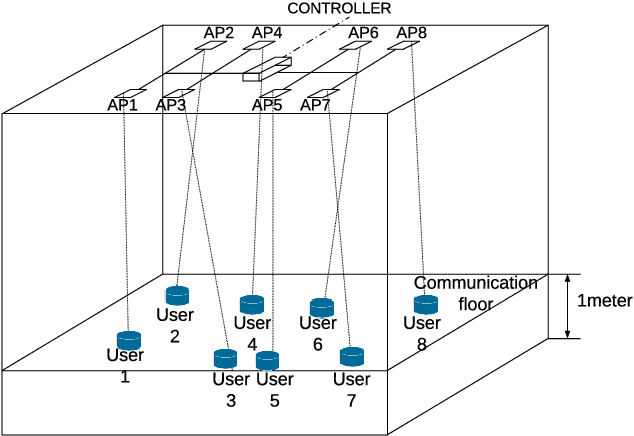
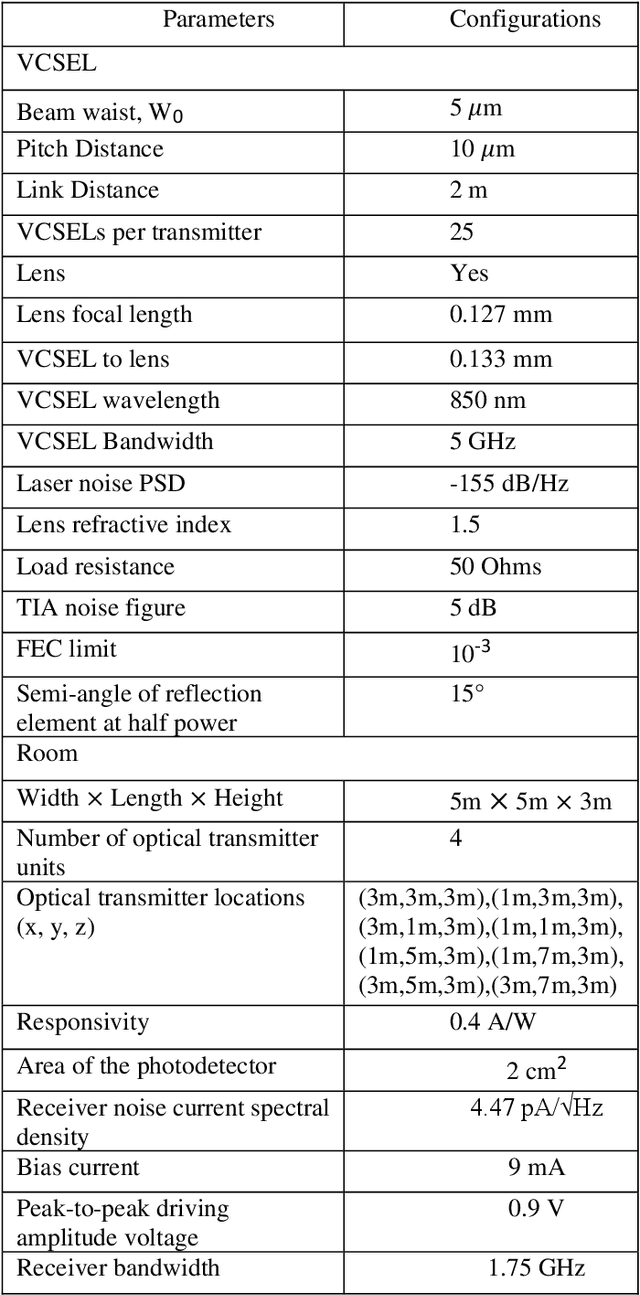
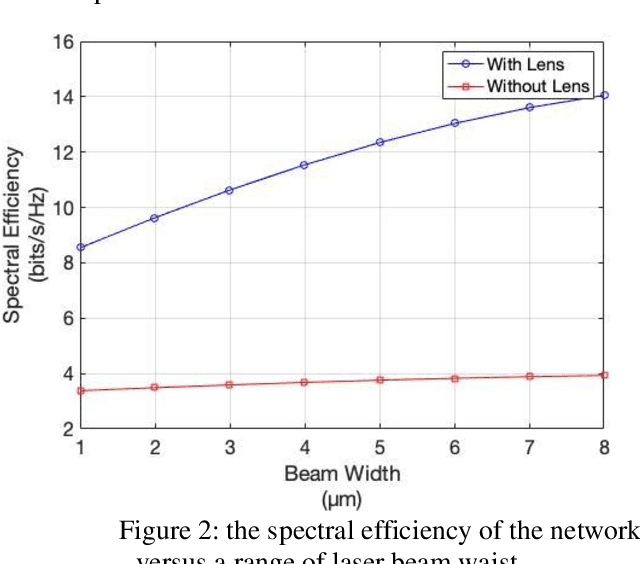
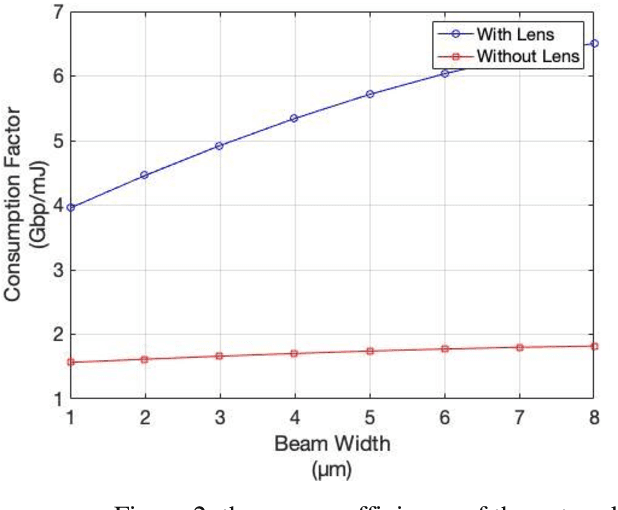
Abstract:Optical wireless Communication (OWC) is a strong candidate in the next generation (6G) of cellular networks. In this paper, a laser-based optical wireless network is deployed in an indoor environment using Vertical Cavity Surface Emitting Lasers (VCSELS) as transmitters serving multiple users. Specifically, a commercially available low-cost VCSEL operating at 850nm wavelength is used. Considering the confined coverage area of each VCSEL, an array of VCSELs is designed to transmit data to multiple users through narrow beams taking into account eye safety regulations. To manage multi-user interference (MUI), Zero Forcing (ZF) is implemented to maximize the multiplexing gain of the network. The energy efficiency of the network is studied under different laser beam waists to find the effective laser beam size that results in throughput enhancement. The results show that the energy efficiency increases with the laser beam waist. Moreover, using micro lenses placed in front of the VCSELs leads to significant increase in the energy efficiency.
Resource Allocation in Laser-based Optical Wireless Cellular Networks
Nov 27, 2021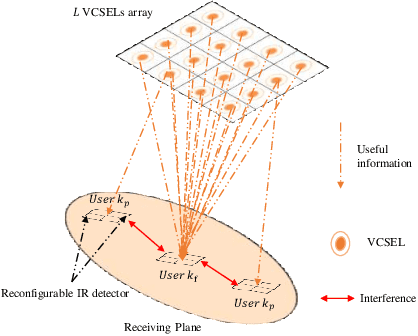
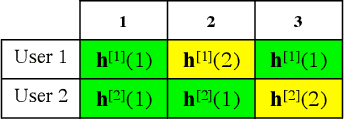
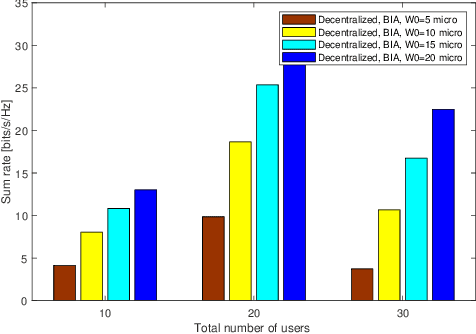
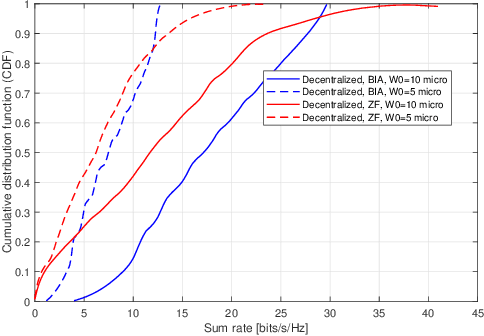
Abstract:Optical wireless communication provides data transmission at high speeds which can satisfy the increasing demands for connecting a massive number of devices to the Internet. In this paper, vertical-cavity surface-emitting(VCSEL) lasers are used as transmitters due to their high modulation speed and energy efficiency. However, a high number of VCSEL lasers is required to ensure coverage where each laser source illuminates a confined area. Therefore, multiple users are classified into different sets according to their connectivity. Given this point, a transmission scheme that uses blind interference alignment (BIA) is implemented to manage the interference in the laser-based network. In addition, an optimization problem is formulated to maximize the utility sum rate taking into consideration the classification of the users. To solve this problem, a decentralized algorithm is proposed where the main problem is divided into sub-problems, each can be solved independently avoiding complexity. The results demonstrate the optimality of the decentralized algorithm where a sub-optimal solution is provided. Finally, it is shown that BIA can provide high performance in laser-based networks compared with zero forcing (ZF) transmit precoding scheme.
On Optimizing Rate Splitting in Laser-based Optical Wireless Networks
Nov 14, 2021



Abstract:Optical wireless communication (OWC) is a promising technology that has the potential to provide Tb/s aggregate rates. In this paper, interference management is studied in a Laser-based optical wireless network where vertical-cavity surface-emitting (VCSEL) lasers are used for data transmission. In particular, rate splitting (RS) and hierarchical rate splitting (HRS) are proposed to align multi-user interference, while maximizing the multiplexing gain of the network. Basically, RS serves multiple users simultaneously by splitting a message of a user into common and private messages, each message with a certain level of power, while on the other side users decode their messages following a specific methodology. The performance of the conventional RS scheme is limited in high density wireless networks. Therefore, the HRS scheme is developed aiming to achieve high rates where users are divided into multiple groups, and a new message called outer common message is used for managing inter-group interference. We formulate an optimization problem that addresses power allocation among the messages of the HRS scheme to further enhance the performance of the network. The results show that the proposed approach provides high achievable rates compared with the conventional RS and HRS schemes in different scenarios.
Blind Interference Alignment in 6G Optical Wireless Communications
Sep 25, 2021



Abstract:In recent years, the demand for high speed wireless networking has increased considerably due to the enormous number of devices connected to the Internet. In this context, optical wireless communication (OWC) has received tremendous interest in the context of next generation wireless networks where OWC offers a huge unlicensed bandwidth using optical bands. OWC systems are directional and can naturally provide multiple-input and multiple-output (MIMO) configurations serving multiple users using a high number of transmitters in the indoor environment to ensure coverage. Therefore, multiuser interference must be managed efficiently to enhance the performance of OWC networks considering different metrics. A transmission scheme referred to as blind interference alignment (BIA) is proposed for OWC systems to maximize the multiplexing gain without the need for channel state information (CSI) at the transmitters, which is difficult to achieve in MIMO scenarios. However, standard BIA avoids the need for CSI at the cost of requiring channel coherence time large enough for transmitting the whole transmission block. Moreover, the methodology of BIA results in increased noise with increase in the number of transmitters and users. Therefore, various network topologies such as network centric (NC) and user centric (UC) designs are proposed to relax the limitations of BIA where these topologies divide the receiving area into multiple clusters. The results show a significant enhancement in the performance of topological BIA compared with standard BIA.
 Add to Chrome
Add to Chrome Add to Firefox
Add to Firefox Add to Edge
Add to Edge